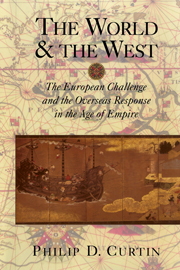Book contents
- Frontmatter
- Contents
- Preface
- Part One Conquest
- Part Two Culture Change and Imperial Rule
- 4 Culture Change in Plural Societies: South Africa and Central Asia
- 5 Culture Change in Mexico
- 6 Administrative Choices and Their Consequences: Examples from Bengal, Central Asia, Java, and Malaya
- Part Three Conversion
- Part Four Independence and the Liquidation of Empires
- Index
4 - Culture Change in Plural Societies: South Africa and Central Asia
Published online by Cambridge University Press: 05 June 2012
- Frontmatter
- Contents
- Preface
- Part One Conquest
- Part Two Culture Change and Imperial Rule
- 4 Culture Change in Plural Societies: South Africa and Central Asia
- 5 Culture Change in Mexico
- 6 Administrative Choices and Their Consequences: Examples from Bengal, Central Asia, Java, and Malaya
- Part Three Conversion
- Part Four Independence and the Liquidation of Empires
- Index
Summary
The process model of voyage, fort, empire takes little or no account of plural societies that also sprang up in the gap between territorial empire on the one hand and true colonization on the other. The earliest to be formed were in Indo- America, the countries along the backbone of the Americas from Mexico south to Bolivia, Paraguay, and parts of Argentina and Chile. The cultural mixture there is highly diverse: in some countries separate Indian communities live in relative isolation; in others, such as Mexico, Indian and Spanish cultures have integrated over the centuries, so that the majority culture is more Mexican than either.
Another set of American plural societies emerged from the plantation complex in the Caribbean and eastern South America. People from Africa were present almost everywhere, and their cultures blended to create a new, Creole culture. After the end of the African slave trade, massive immigration of indentured laborers from India created in some places a separate East Indian cultural community. The European community was often very small, but it was a majority in some islands such as Cuba and Puerto Rico.
A similar group of plural societies exists in Southeast Asia, where cultural pluralism resulted from migration within the tropical world, not from a significant community of European settlers. The largest immigrant group was Chinese, whose arrival, especially in the 1800s, made them the majority ethnic community in Singapore and a large minority in Malaysia, Thailand, and Indonesia. Indian immigrants at this same period became an important cultural community in Singapore, lower Burma, and Malaysia.
- Type
- Chapter
- Information
- The World and the WestThe European Challenge and the Overseas Response in the Age of Empire, pp. 57 - 72Publisher: Cambridge University PressPrint publication year: 2000



